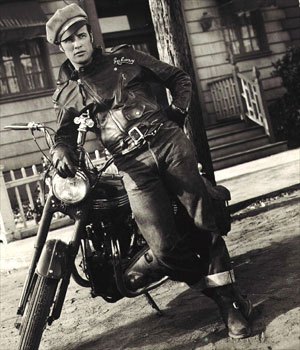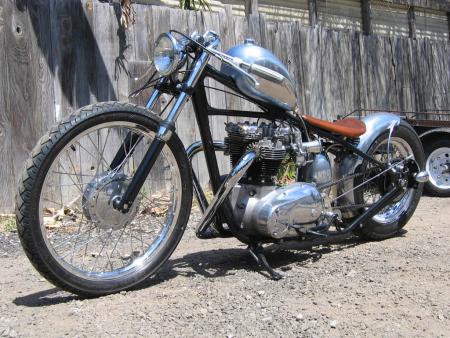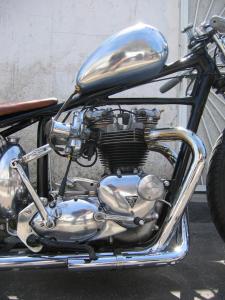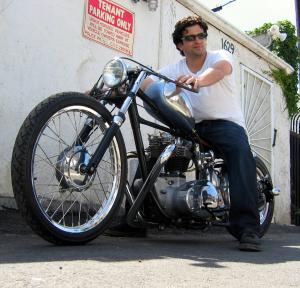 |
| Brando and his Triumph in The Wild One. |
Triumph was founded in 1886 by a German immigrant to London, one Siegfried Bettman who came up with the name for his bicycles. By 1902 he was hanging motors (Belgian made) in the spindly frames and producing motor-cycles from new headquarters in Coventry. Three years later, Triumph was making its own 100% bikes. Fifty years later, they latched onto another famous moniker, the Triumph Bonneville, and as they say, the rest is history.
The Thunderbird was introduced in 1950 and then in 1958 the famous Bonneville launched itself into motorcycling history. Sales were more than brisk, some 48,000 Triumphs produced in the banner year 1969. But after some 20 years of economic troubles and corporate wheeling-dealing, the company was dissolved in 1983.
A new owner with a new vision, John Bloor, revived the company in 1990 and built a new factory in Hinckley where he unveiled a whole new species of Triumph in 1992. They would enter the U.S. market in 1995, followed by a re-launch of the famous Bonneville in 2000. Over the next several years the company prospered thanks to high-quality machines that attract a whole new generation of riders.
In any case, people have been “chopping” or customizing Triumphs, aka Trumpets, since they were chopping and customizing Harleys, the choice a function of geography and finances. In recent years there’s been a re-boom of interest in Triumph customs, both the classics of the 1960s-70s and even the new batch of “modern” Triumphs. But you just can’t beat a late-’60s 650cc Triumph for character, attitude, trim good looks and enough power to bridge the fun gap between the 20th and the 21st centuries.
Seen here are four Southern California variations on a Triumph chopper theme, bikes built by individuals each with a unique perspective on what constitutes a Brit Bike Gone Baaaddddd!

The Harbortown Bobber, aka Movie Bike
Beating the odds, Scott DiLalla fused his passion for bikes and film and started up One World Studios, and went on to create the award-winning Choppertown and Brittown movies. Looking for a new two-wheeled “star,” he decided to design his own vision of the perfect Triumph chopper, eventually calling it The Harbortown Bobber, also the name of his latest film project. Earl Kane, previously mentioned, would also play a major role in its creation.
“I have always loved motorcycles. Working on them, riding them…. everything. I grew up in New York just outside of the city and all my friends were into American iron, so naturally I was, too. Then one day I saw the coolest chopper I had ever seen and it happened to be a Triumph. I got my first Triumph in 2006 and even ended up buying two in that one week.”
A couple years later he began his new project seen here which began with two bikes he bought as parts bikes, most of a 1969 Triumph and a1971 Triumph Bonneville café project that had gone nowhere, its 750cc motor eventually powering the Harbortown Bobber. As he set about designing and hunting for parts, Scott focused on a hard-to-find Wassell peanut tank then had it modified to his vision, including a new tunnel and relocation of the filler hole.
The oil tank and fenders are fabricated from spun steel, while tire choices were a 16-inch in the rear and 21-inch in the front.
“The wider rear tire (130 Metzler) and the form-fitting fender add a sense of weight to the rear which helps give it that different look when compared to other Triumphs,” Scott explains.
The frame was a different matter. Scott drove the 1400 miles along famous Route 66 to Denver, Colorado and a shop called Shamrock Fabrication to put his hands on it. “We did 3,000 miles in one week, but it was worth it,” says Scott.
At this point, Earl Kane was bought into put it all together while the film recorded the process as part of the film, art imitating life in reverse.
“We spent most of our shooting days in Earl’s shop until the bike was completed, watching as he fabricated a seat, license-plate bracket, cool chain tensioner, fork stop bungs, a headlight mount, even painted the tank.”
Earl also introduced Scott to jet coating (ceramic coating), a process similar to powder coating that car guys use to insulate their exhaust pipes as well as give them an aluminum finish. The treatment was applied to the bike’s gas tank, oil bag, and fender with the resulting polished aluminum look.
A final touch was a custom leather seat hand tooled by Gilbert Gonzales, capping off a two-year odyssey for the building and filming the Harbortown Bobber. (More info about the movie at http://www.harbortownbobber.com/)


No comments:
Post a Comment